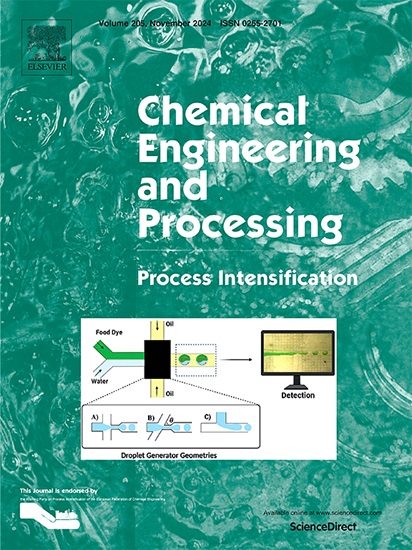A state of the art treatment route of flue gases using microbubbles
IF 3.8
3区 工程技术
Q3 ENERGY & FUELS
Chemical Engineering and Processing - Process Intensification
Pub Date : 2025-06-17
DOI:10.1016/j.cep.2025.110418
引用次数: 0
Abstract
The article presents a state-of-the-art method of removal of flue gases through the incorporation of microbubbles in the wet oxidation system. The solubility of SO2 and NOX in water is the primary determinant for their simultaneous elimination in the wet oxidation process. SO2 is soluble in water under specific optimal conditions, but NOX is nearly insoluble. However, application of suitable oxidants can transform NO/NO2 into water-soluble HNO3. In this work, instead of expensive oxidation routes, the enhancement of flue gas mass transfer rate have been tested by incorporating microbubbles in the system. To overcome the challenge of lower NOx reactivity, Hydrogen peroxide served as the primary and only oxidant, while MBs facilitated the solubility and absorption rates of SO2 and NOX in water. Several mass transfer properties act as the controlling factors for the process were evaluated to showcase the effectiveness of the process. Sauter mean diameter, gas holdup, specific interfacial area, volumetric coefficient for liquid phase mass transfer, kinetic parameters, Hatta number, and thermodynamic factors were assessed to understand their contribution to the mass transfer and reaction kinetics. The microbubble-assisted H2O2 oxidative technique for elimination of SO2 and NOX was shown to be highly successful.

利用微气泡处理烟气的最新技术路线
本文介绍了一种通过在湿式氧化系统中加入微泡来去除烟气的最先进方法。SO2和NOX在水中的溶解度是湿式氧化过程中同时消除它们的主要决定因素。在特定的最佳条件下,SO2可溶于水,而NOX几乎不溶于水。然而,使用合适的氧化剂可以将NO/NO2转化为水溶性HNO3。在这项工作中,通过在系统中加入微气泡来测试烟气传质速率的提高,而不是昂贵的氧化路线。为了克服NOx反应性较低的挑战,过氧化氢作为主要和唯一的氧化剂,而MBs促进了SO2和NOx在水中的溶解度和吸收率。对控制该工艺的几个传质特性进行了评价,以证明该工艺的有效性。评估了Sauter平均直径、气含率、比界面面积、液相传质体积系数、动力学参数、哈塔数和热力学因素,以了解它们对传质和反应动力学的贡献。微泡辅助H2O2氧化技术对SO2和NOX的去除是非常成功的。
本文章由计算机程序翻译,如有差异,请以英文原文为准。
求助全文
约1分钟内获得全文
求助全文
来源期刊
CiteScore
7.80
自引率
9.30%
发文量
408
审稿时长
49 days
期刊介绍:
Chemical Engineering and Processing: Process Intensification is intended for practicing researchers in industry and academia, working in the field of Process Engineering and related to the subject of Process Intensification.Articles published in the Journal demonstrate how novel discoveries, developments and theories in the field of Process Engineering and in particular Process Intensification may be used for analysis and design of innovative equipment and processing methods with substantially improved sustainability, efficiency and environmental performance.

 求助内容:
求助内容: 应助结果提醒方式:
应助结果提醒方式:


